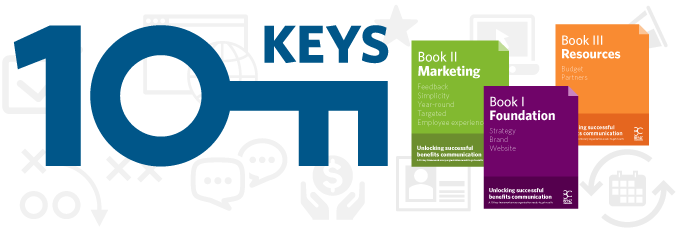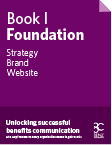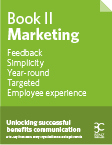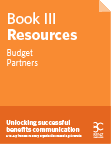
Don’t miss the release of our 10-key framework for successful benefits communication

Over the past 11 and a half years, we’ve worked with more than 50 companies (primarily Fortune 500 companies, and many 100 Best Companies to Work For), and we’ve researched hundreds more. During that time, we’ve seen clear patterns emerge, and we’ve tested and honed our best practices. Our clients have seen remarkable success with engagement in two ways: tying benefits to the employee value proposition and getting employees to engage with the benefits themselves.
Now, we’re handing you the keys to unlock the secret to exceptional employee benefits communication.
I’m delighted to announce our new 3-ebook series, Unlocking Successful Benefits Communication: A 10-key Framework Every Organization Needs to Get Results. The ebooks offer a blueprint for envisioning, planning, and implementing effective communication, as well as practical tips for applying each key to your organization.
We’re thrilled to be able to share this series with you:
- Book I: Foundation—Get it now
- Book II: Marketing—Get it now
- Book III: Resources—Get it now
Here’s a preview of what you’ll find in each ebook.
The 10 Keys to Successful Benefits Communication
 Book I: Foundation
Book I: Foundation
Your foundation is the first place to invest. Organizations that don’t have a few crucial elements in place flounder to get their benefits communication efforts off the ground. The first step to establishing your foundation is to create a communication strategy. Without it, nothing will have direction or a unified purpose. Next, you need to have a strong brand so that your communications have a recognizable look, feel, and tone. Finally, you need to have a single place where employees can go to easily access information whenever they need to.
- Strategy: Your communication strategy outlines why you are communicating and how you will do it. It should outline what your goals are, who you’re communicating with and how you’ll reach these individuals. Think of your strategy as an enhanced roadmap—a means of getting your organization and employees from point A to point B. We show you each of the elements of a good strategy and share insights for how to develop one for your organization.
- Brand: Your brand is not simply the logo, color scheme, and tone used in your communications—it’s all that and more. It’s the feeling of recognition someone gets when they see an ad for a familiar company. A brand helps create a consistent and predictable experience, which builds trust and loyalty. We take you through how to ensure your brand is consistently applied, and give tips for developing your own benefits brand, as well.
- Website: A benefits website is a one-stop shop for employees and families to learn about their benefits and take action. Ideally, it is accessible outside the firewall and without a password, and has a URL that is easy to remember. You’ll discover what makes a benefits website great and how to launch one within your organization.
 Book II: Marketing approach
Book II: Marketing approach
The best way to get employees to engage in your benefits is by borrowing a page from the consumer marketing playbook. Learn how to collect and use employee feedback, simplify your communications, target and segment your audience, and use a variety of channels to communicate throughout the year. Mastering these techniques will take your communication efforts to the next level and drive real results.
- Feedback: Feedback is your employees’ thoughts on the programs you offer, what they need/want, and how they prefer to be communicated with. You need it to gain insight and empathy into the very people for whom you’re creating solutions. It’s vital to understand what’s important to your employees, what motivates them, what their goals are, and where they get stuck. We cover the different ways to gather feedback, which methods are best for you, and how to use them.
- Simplicity: This is about making things as easy as possible to understand. Despite the best of intentions, this is often where HR teams fall short. Not for the lack of trying, but, because it’s easy to forget that not everyone knows the topic as well as you do. Our checklist shows you all the ways to simplify your communications (hint: it’s more than just the words you choose!).
- Multi-channel, year-round: This approach means using a variety of communication channels to address different learning styles and keep the conversation going throughout the year. We share all the different channels available for use, considerations for implementing them, and how to create a year-round communication plan.
- Targeted messaging: Casting a wide net doesn’t necessarily catch more fish when it comes to communication. Targeted messaging is a very specific approach to communications. Instead of sending one message to your entire population, you can use targeted messaging to get the right message to the right person at the right time. Learn the different ways to target your communications.
- Employee experience: At Benz, the employee experience means looking at the big picture—connecting programs for employees, beginning with the day they walk in the door and continuing until their last day of work—and beyond. It’s all about what the employee actually experiences throughout that journey, and putting everything available to them into context. See the role you play in shaping your employees’ experience at work, and learn how to enhance it.
 Book III: Resources
Book III: Resources
The biggest impediment to developing more effective communications is resources. You know you could be doing more, but you don't have the budget, or your team doesn't have the time or expertise. Resources are so important because everything we've talked about takes time, effort, and expertise to happen.
- Budget: Your budget is the dollars allocated specifically for benefits communication. It should be large enough to cover and support your optimal communication plan. We outline when it makes sense for your organization to start investing more in benefits communication, and how to make a business case for budget.
- Partners: You have an extensive network of partners who can help you achieve your goals. We identify ways to integrate your vendors—and your internal partners—to support communications.
We’re thrilled to be able to share this series with you:
- Book I: Foundation—Get it now
- Book II: Marketing—Get it now
- Book III: Resources—Get it now
We're proud to work with large employers who recognize the business value of engaging employees in benefits. If you want to learn more, contact us.
Work with Us
We partner with organizations that value their people first. Let’s talk.

Jennifer Benz, SVP Communications Leader, has been on the leading edge of employee benefits for more than 20 years and is an influential voice in the employee benefits industry.
